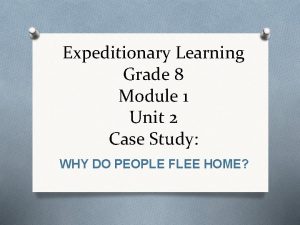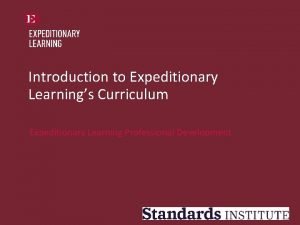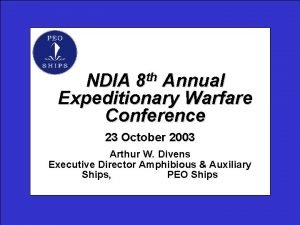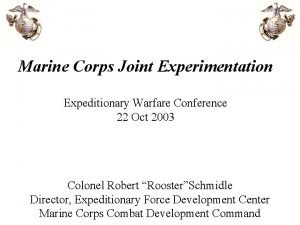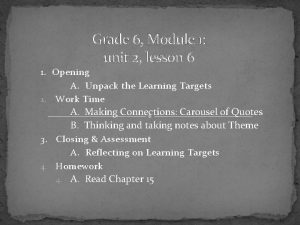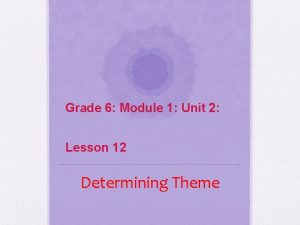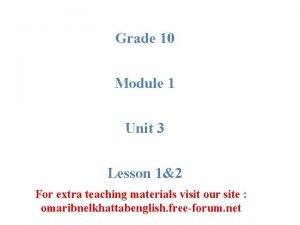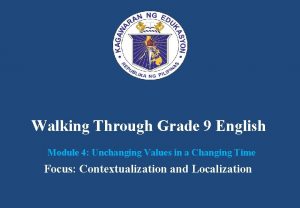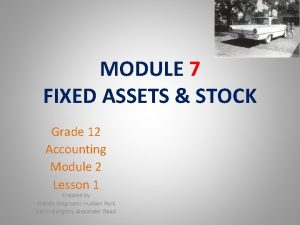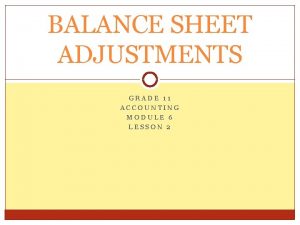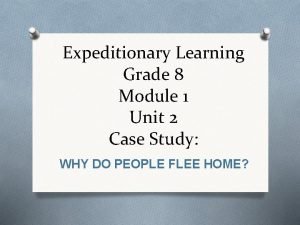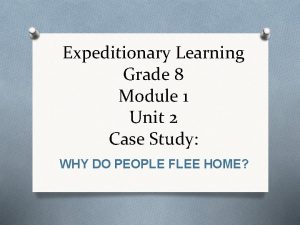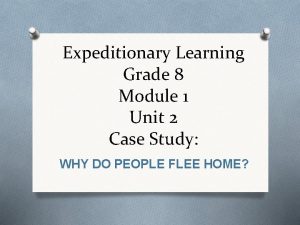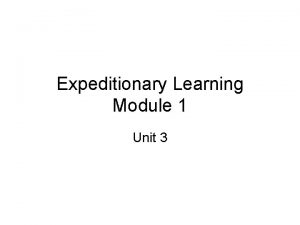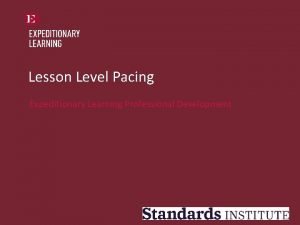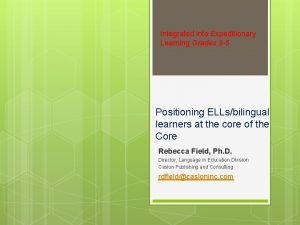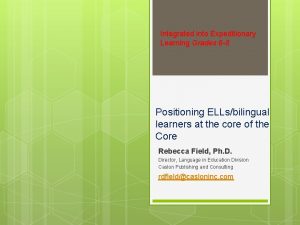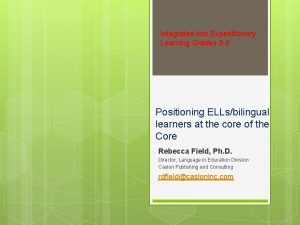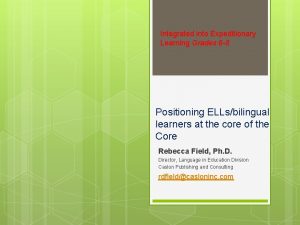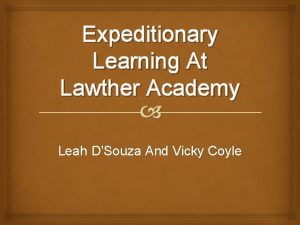Expeditionary Learning Grade 8 Module 1 Unit 2














- Slides: 14

Expeditionary Learning Grade 8 Module 1 Unit 2 Case Study: WHY DO PEOPLE FLEE HOME?

Lesson #19 Launching Researching: Reading for Gist and Gathering Evidence Using the Research Guide

Learning Objective: Students will conduct research and gather information about refugees by using a guide that addresses the who, where, and why questions. • CCLS: O I can conduct short research projects to answer a question. (W. 8. 7) O I can use evidence from informational texts to support analysis, reflection, and research. (W. 8. 9) O I can express my own ideas clearly during discussions, and I can build on other’s ideas during discussions. (SL. 8. 1)

Lesson Vocabulary gist strongest evidence

Research Teams O Everybody should be sitting with research teams. Kurdish Refugee Bosnian Refugee Afghani Refugee Anthony B Karina Julian Lillyann Anthony L Jazmin M Jayline Dario Natanael Romeo Jamarius Mariah Noa Abigail Donte Kyla Gianely Christina Josiah Karla Jasmine G Julian M Isaac William Jacquelin Vontae

LEARNING TARGETS: O I can find the gist of What is gist? informational texts. O I can select the strongest evidence in an informational text about who the refugees were, where they fled from, and why they had to flee. What does it mean by strongest evidence?

The Research Guide pg. 132 Strongest Evidence from Sources Source Information Article title, author, and page # Who is your refugee? (include information about distinguishing categories; for example, race, nationality, religion, political affiliation) Think-Pair-Share: *Look at the lefthand column of the Research Where is your refugee from? Where did he or she flee to? Guide. What do (include information about both places and time period) you think you are going to record in each row of this column? Why? Why did your refugee flee? (include information to support why people fled the country; for example, war or natural disaster, religious reasons—include specific information on a historical event) Think-Pair. Share: *What do you think you are going to record in the right-hand column of the Research Guide? Why? ”

Article Assignments Kurdish Refugees Articles 1. (Page 135) “A Place of Her Own. ” 2. (Page 137)“People without a Land. ” 3. (Page 139) “Meet the Kurds. ” Bosnian Refugees Articles: 1. (Page 141 -143) “Welcome to Sarajevo. ” 2. (Page 144 -147). “Bosnia: The Children of War. ” 3. (Page 148 -151) “Hard Times in Sarajevo: Cold Weather Comes Early to Bosnia’s War-Torn Capital, Bringing More Hardship, Death. ” 4. (Page 152 -154) “Peace Patrol: U. S. Troops Will Stay at Least Another Year in Tense Bosnia. ” Afghani Refugees Articles: 1. (Page 155 -158) “Refugee Writing on the Journey. ” 2. (Page 159) “I Escaped the Taliban. ” 3. (Page 160 -162)“Town Mouse and Country Mouse. ”

Reading All Research Texts for Gist O In this lesson, you get to dig into the research to find out more about a specific group of refugees. As a research team, you are going to find the gist of the materials within the workbooks and articles that I have listed so that you can figure out what the text is mostly about before you begin looking for particular details. O Turn to the Research Task Cards on page 133 Workbook. Focus on Part A: Reading for Gist. Reading for gist is something real researchers do. Read the informational texts in your Research Folders for gist.

Reading One Research Text to Identify “Who? Where? Why? ” Details O Now that you have gotten a sense of the gist of the various texts in their folders, you will work in pairs to read just one text in more detail.

Title: “Meet the KURDS” Follow the Part B directions to identify and Author(s): underline in colored Vera Saeedpour pencils the specific Source: information to answer Faces: People, Places, and Cultures. 15. 7 (Mar. 1999): p 8. the Who? Where? Document Type: Why? questions. Article Full Text: COPYRIGHT 1999 Cobblestone Publishing, a division of Carus Publishing Company www. cobblestonepub. com/ Full Text: When you think of the Middle East, you might imagine palm trees, camels, and deserts. This is not the Middle East of the Kurds. Kurdish country is a land of high mountains and great rivers. The Kurds live in a region called Kurdistan, which appeared on maps prior to World War I. Much of the region consists of areas in the central and northern Zagros Mountains, the eastern two-thirds of the Taurus and Pontus Mountains, and the northern half of the Amanus Mountains. The 230, 000 square miles that make up Kurdistan are stretched across the countries of Turkey, Syria, Iraq, and Iran. Kurds are the fourth largest ethnic group in the Middle East, but they have no modern nation of their own. Throughout this century and earlier, Kurds have fought to regain control over their ancestral territories. They want to be a respected nation among nations. The Kurdish independence fighters are called peshmerga (those who face death). As in every conflict the world over, the Kurdish civilians suffer most from the Kurdish struggle for self-determination. Until recently, Kurds in Turkey were not allowed to speak their own language in public or practice their customs.

Gathering Evidence on Research Guides In Unit 3, you are going to use the answers from your Research Guide to be creative and write “inside out” and “back again” poems. O Turn to page 123 in your E. L. Books. O Strongest Evidence from Sources Who is your refugee? (include information about distinguishing categories; for example, race, nationality, religion, political affiliation) Where is your refugee from? Where did he or she flee to? (include information about both places and time period) Why did your refugee flee? (include information to support why people fled the country; for example, war or natural disaster, religious reasons—include specific information on a historical event) Source Information Article title, author, and page #

Closing: Sharing Evidence O Go back to your original Numbered Heads groups. O Pair Up-Numbered Heads 1 with 2 and 3 with 4. Share your answer to the following question, based on the evidence you have collected so far on your Research Guides: Keep thinking about the strongest *Now evidence that youyouhave looked through the collected as you storiesresearched of refugees, today: who are the refugees *Which details seem from this specific timemost andrelevant place given in history? the poems you are preparing to write? What Why? do you know about them?

Homework A. For the text you read with your partner, finish recording the strongest Who? Where? Why? evidence onto your Research Guide. Read other texts if you choose.
 Expeditionary learning grade 8
Expeditionary learning grade 8 Expeditionary learning curriculum
Expeditionary learning curriculum Ndia expeditionary warfare conference
Ndia expeditionary warfare conference Expeditionary warfare conference
Expeditionary warfare conference Grade 6, module 1, unit 2 answer key
Grade 6, module 1, unit 2 answer key Grade 6 module 1: unit 2 answer key
Grade 6 module 1: unit 2 answer key English module grade 10 unit 3
English module grade 10 unit 3 Cuadro comparativo entre e-learning b-learning y m-learning
Cuadro comparativo entre e-learning b-learning y m-learning C device module module 1
C device module module 1 Unit 10, unit 10 review tests, unit 10 general test
Unit 10, unit 10 review tests, unit 10 general test Grade 9 english module
Grade 9 english module Principles of marketing grade 11 module 2 answer key
Principles of marketing grade 11 module 2 answer key Fixed assets accounting grade 12
Fixed assets accounting grade 12 Proportion in business math
Proportion in business math Grade 11 balance sheet
Grade 11 balance sheet
